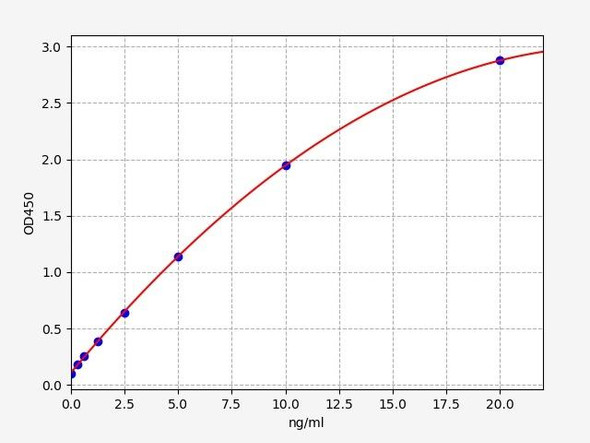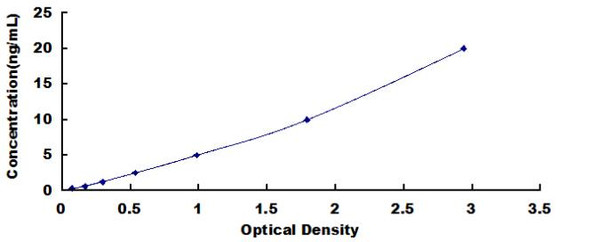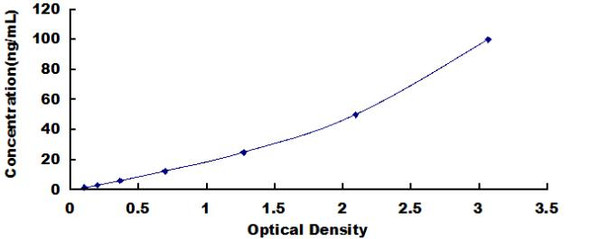Human Immunology ELISA Kits 1
Human CR2/CD21 (Complement Receptor 2) CLIA Kit (HUES00921)
- SKU:
- HUES00921
- Product Type:
- ELISA Kit
- ELISA Type:
- CLIA Kit
- Size:
- 96 Assays
- Sensitivity:
- 37.5pg/mL
- Range:
- 62.5-4000pg/mL
- ELISA Type:
- Sandwich
- Reactivity:
- Human
- Sample Type:
- Serum, plasma and other biological fluids
- Research Area:
- Immunology
Description
| Assay type: | Sandwich |
| Format: | 96T |
| Assay time: | 4.5h |
| Reactivity: | Human |
| Detection method: | Chemiluminescence |
| Detection range: | 62.50-4000 pg/mL |
| Sensitivity: | 37.50 pg/mL |
| Sample volume: | 100µL |
| Sample type: | Serum, plasma and other biological fluids |
| Repeatability: | CV < 15% |
| Specificity: | This kit recognizes Human CR2/CD21 in samples. No significant cross-reactivity or interference between Human CR2/CD21 and analogues was observed. |
This kit uses Sandwich-CLIA as the method. The micro CLIA plate provided in this kit has been pre-coated with an antibody specific to Human CR2/CD21. Standards or samples are added to the appropriate micro CLIA plate wells and combined with the specific antibody. Then a biotinylated detection antibody specific for Human CR2/CD21 and Avidin-Horseradish Peroxidase (HRP) conjugate are added to each micro plate well successively and incubated. Free components are washed away. The substrate solution is added to each well. Only those wells that contain Human CR2/CD21, biotinylated detection antibody and Avidin-HRP conjugate will appear fluorescence. The Relative light unit (RLU) value is measured spectrophotometrically by the Chemiluminescence immunoassay analyzer. The RLU value is positively associated with the concentration of Human CR2/CD21. The concentration of Human CR2/CD21 in the samples can be calculated by comparing the RLU of the samples to the standard curve.
| UniProt Protein Function: | CR2: Receptor for complement C3Dd, for the Epstein-Barr virus on human B-cells and T-cells and for HNRPU. Participates in B lymphocytes activation. Genetic variations in CR2 are associated with susceptibility to systemic lupus erythematosus type 9 (SLEB9). Systemic lupus erythematosus (SLE) is a chronic autoimmune disease with a complex genetic basis. SLE is an inflammatory, and often febrile multisystemic disorder of connective tissue characterized principally by involvement of the skin, joints, kidneys, and serosal membranes. It is thought to represent a failure of the regulatory mechanisms of the autoimmune system. Defects in CR2 are the cause of immunodeficiency, common variable, type 7 (CVID7). A primary immunodeficiency characterized by antibody deficiency, hypogammaglobulinemia, recurrent bacterial infections and an inability to mount an antibody response to antigen. The defect results from a failure of B-cell differentiation and impaired secretion of immunoglobulins; the numbers of circulating B cells is usually in the normal range, but can be low. Belongs to the receptors of complement activation (RCA) family. 4 isoforms of the human protein are produced by alternative splicing. |
| UniProt Protein Details: | Protein type:Membrane protein, integral; Receptor, misc. Chromosomal Location of Human Ortholog: 1q32 Cellular Component: receptor complex Molecular Function:complement binding; DNA binding; protein homodimerization activity Biological Process: B cell differentiation; B cell proliferation Disease: Immunodeficiency, Common Variable, 2; Immunodeficiency, Common Variable, 7; Systemic Lupus Erythematosus, Susceptibility To, 9 |
| NCBI Summary: | This gene encodes a membrane protein, which functions as a receptor for Epstein-Barr virus (EBV) binding on B and T lymphocytes. Genetic variations in this gene are associated with susceptibility to systemic lupus erythematosus type 9 (SLEB9). Alternatively spliced transcript variants encoding different isoforms have been found for this gene. [provided by RefSeq, Sep 2009] |
| UniProt Code: | P20023 |
| NCBI GenInfo Identifier: | 215273962 |
| NCBI Gene ID: | 1380 |
| NCBI Accession: | P20023. 2 |
| UniProt Secondary Accession: | P20023,Q13866, Q14212, Q53EL2, Q5BKT9, Q5SR46, Q5SR48 C9JHD2, |
| UniProt Related Accession: | P20023 |
| Molecular Weight: | |
| NCBI Full Name: | Complement receptor type 2 |
| NCBI Synonym Full Names: | complement component 3d receptor 2 |
| NCBI Official Symbol: | CR2 |
| NCBI Official Synonym Symbols: | CR; C3DR; CD21; CVID7; SLEB9 |
| NCBI Protein Information: | complement receptor type 2 |
| UniProt Protein Name: | Complement receptor type 2 |
| UniProt Synonym Protein Names: | Complement C3d receptor; Epstein-Barr virus receptor; EBV receptor; CD_antigen: CD21 |
| Protein Family: | Complement receptor |
| UniProt Gene Name: | CR2 |
| UniProt Entry Name: | CR2_HUMAN |
As the RLU values of the standard curve may vary according to the conditions of the actual assay performance (e. g. operator, pipetting technique, washing technique or temperature effects), the operator should establish a standard curve for each test. Typical standard curve and data is provided below for reference only.
| Concentration (pg/mL) | RLU | Average | Corrected |
| 4000 | 58986 59176 | 59081 | 59046 |
| 2000 | 25224 30494 | 27859 | 27824 |
| 1000 | 13925 13043 | 13484 | 13449 |
| 500 | 6527 6683 | 6605 | 6570 |
| 250 | 3308 3178 | 3243 | 3208 |
| 125 | 1653 1509 | 1581 | 1546 |
| 62.50 | 729 781 | 755 | 720 |
| 0 | 34 36 | 35 | -- |
Precision
Intra-assay Precision (Precision within an assay): 3 samples with low, mid range and high level Human CR2/CD21 were tested 20 times on one plate, respectively.
Inter-assay Precision (Precision between assays): 3 samples with low, mid range and high level Human CR2/CD21 were tested on 3 different plates, 20 replicates in each plate.
| Intra-assay Precision | Inter-assay Precision | |||||
| Sample | 1 | 2 | 3 | 1 | 2 | 3 |
| n | 20 | 20 | 20 | 20 | 20 | 20 |
| Mean (pg/mL) | 216.32 | 413.63 | 1365.60 | 229.97 | 429.87 | 1324.67 |
| Standard deviation | 21.52 | 30.69 | 110.07 | 27.96 | 39.08 | 146.91 |
| C V (%) | 9.95 | 7.42 | 8.06 | 12.16 | 9.09 | 11.09 |
Recovery
The recovery of Human CR2/CD21 spiked at three different levels in samples throughout the range of the assay was evaluated in various matrices.
| Sample Type | Range (%) | Average Recovery (%) |
| Serum (n=5) | 85-98 | 91 |
| EDTA plasma (n=5) | 93-108 | 100 |
| Cell culture media (n=5) | 90-106 | 98 |
Linearity
Samples were spiked with high concentrations of Human CR2/CD21 and diluted with Reference Standard & Sample Diluent to produce samples with values within the range of the assay.
| Serum (n=5) | EDTA plasma (n=5) | Cell culture media (n=5) | ||
| 1:2 | Range (%) | 98-114 | 101-115 | 94-109 |
| Average (%) | 106 | 107 | 101 | |
| 1:4 | Range (%) | 95-109 | 93-107 | 86-99 |
| Average (%) | 102 | 100 | 93 | |
| 1:8 | Range (%) | 95-109 | 86-98 | 90-103 |
| Average (%) | 101 | 92 | 96 | |
| 1:16 | Range (%) | 87-101 | 91-106 | 89-100 |
| Average (%) | 95 | 98 | 94 |
An unopened kit can be stored at 4°C for 1 month. If the kit is not used within 1 month, store the items separately according to the following conditions once the kit is received.
| Item | Specifications | Storage |
| Micro CLIA Plate(Dismountable) | 8 wells ×12 strips | -20°C, 6 months |
| Reference Standard | 2 vials | |
| Concentrated Biotinylated Detection Ab (100×) | 1 vial, 120 µL | |
| Concentrated HRP Conjugate (100×) | 1 vial, 120 µL | -20°C(shading light), 6 months |
| Reference Standard & Sample Diluent | 1 vial, 20 mL | 4°C, 6 months |
| Biotinylated Detection Ab Diluent | 1 vial, 14 mL | |
| HRP Conjugate Diluent | 1 vial, 14 mL | |
| Concentrated Wash Buffer (25×) | 1 vial, 30 mL | |
| Substrate Reagent A | 1 vial, 5 mL | 4°C (shading light) |
| Substrate Reagent B | 1 vial, 5 mL | 4°C (shading light) |
| Plate Sealer | 5 pieces | |
| Product Description | 1 copy | |
| Certificate of Analysis | 1 copy |
- Set standard, test sample and control (zero) wells on the pre-coated plate and record theirpositions. It is recommended to measure each standard and sample in duplicate. Note: addall solutions to the bottom of the plate wells while avoiding contact with the well walls. Ensuresolutions do not foam when adding to the wells.
- Aliquot 100 µL of standard solutions into the standard wells.
- Add 100 µL of Sample / Standard dilution buffer into the control (zero) well.
- Add 100 µL of properly diluted sample (serum, plasma, tissue homogenates and otherbiological fluids. ) into test sample wells.
- Cover the plate with the sealer provided in the kit and incubate for 90 min at 37 °C.
- Aspirate the liquid from each well, do not wash. Immediately add 100 µL of BiotinylatedDetection Ab working solution to each well. Cover the plate with a plate seal and gently mix. Incubate for 1 hour at 37 °C.
- Aspirate or decant the solution from the plate and add 350 µL of wash buffer to each welland incubate for 1-2 minutes at room temperature. Aspirate the solution from each well andclap the plate on absorbent filter paper to dry. Repeat this process 3 times. Note: a microplatewasher can be used in this step and other wash steps.
- Add 100 µL of HRP Conjugate working solution to each well. Cover with a plate seal andincubate for 30 min at 37 °C.
- Aspirate or decant the solution from each well. Repeat the wash process for five times asconducted in step 7.
- Add 100 µL of Substrate mixture solution to each well. Cover with a new plate seal andincubate for no more than 5 min at 37 °C. Protect the plate from light.
- Determine the RLU value of each well immediately.






